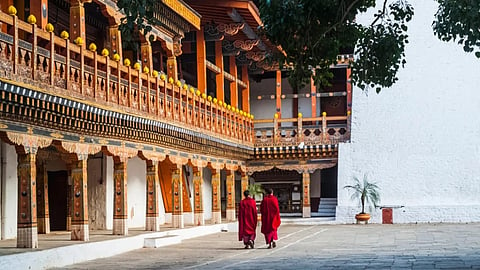
- Destinations
- Experiences
- Stay
- What's new
- Celebrating People
- Responsible Tourism
- CampaignsCampaigns
- Subscribe
- Buy Now

India and Bhutan are stepping into a new era of connectivity. On September 29-30, 2025, New Delhi announced two cross-border railway lines that will grant Bhutan its first railway links, connecting Gelephu and Samtse in Bhutan to Indian towns in Assam and West Bengal. The projects—Kokrajhar-Gelephu and Banarhat-Samtse—are envisioned as catalysts for trade, economic growth, strategic integration, and tighter cultural ties.
This 69-kilometre line will connect Kokrajhar in Assam to Gelephu in Bhutan, marking the Himalayan nation’s first-ever railway entry point. The route will include six stations—Balagaon, Garubhasa, Runikhata, Shantipur, Dadgiri, and Gelephu—and feature extensive infrastructure, including two viaducts, 29 major bridges, 65 minor bridges, two goods sheds, and several underpasses and overpasses. A small section of around 2.4 kilometres will lie inside Bhutanese territory. The project, with an estimated cost of INR 3,456 crore, is slated for completion within four years.
Stretching about 20 kilometres, this route will link Banarhat in West Bengal to Samtse in Bhutan. It will include two stations, a major bridge, 24 minor bridges, one flyover, and 37 underpasses. Roughly two kilometres of the alignment will be in Bhutan, while the remaining section will run through India. The project, estimated at INR 577 crore, is expected to be completed in three years.
Together, these two projects cover nearly 89 kilometres and represent a combined investment of about INR 4,033 crore. The funding will be entirely supported by the Indian government.
Boost To Trade And Connectivity: Until now, Bhutan’s imports and exports have relied heavily on road transport. The introduction of rail links is expected to drastically cut travel time and costs, giving Bhutan easier access to Indian ports and markets. Industrial regions like Samtse and the upcoming Gelephu Mindfulness City are likely to benefit immensely from this logistical upgrade.
Strategic Importance Near The Siliguri Corridor: Both routes pass close to the Siliguri Corridor—India’s narrow, strategically vital land stretch connecting the Northeast to the rest of the country. Improved rail infrastructure in this region not only enhances trade but also strengthens national security and regional resilience.
Modern Infrastructure And Sustainability: The lines will be fully electrified and equipped with advanced signalling systems. Environmental and land acquisition approvals are expected to move swiftly, especially since the Kokrajhar–Gelephu link has been granted “Special Railway Project” status to ensure faster execution.
Deepening India–Bhutan Partnership: The initiative is part of India’s ongoing commitment to Bhutan’s development. Under Bhutan’s 13th Five-Year Plan (2024–29), India has pledged INR 10,000 crore in assistance—double the previous allocation. The rail projects symbolise the next phase of bilateral cooperation, focusing on connectivity alongside the long-standing hydropower and trade collaborations.
As Bhutan joins the railway map for the first time, both nations stand to gain from stronger ties, smoother trade routes, and deeper cultural exchange.
Q1. What are the new cross-border rail projects between India and Bhutan?
India and Bhutan have announced two new railway lines: Kokrajhar–Gelephu (about 69 km) connecting Assam to Bhutan, and Banarhat–Samtse (about 20 km) in West Bengal to Samtse, for Bhutan’s first rail access.
Q2. Why is the Kokrajhar–Gelephu rail link significant?
Kokrajhar–Gelephu will mark Bhutan’s first major rail entry, passing through Indian terrain into Bhutan with modern infrastructure (bridges, viaducts) and electrification, enhancing cross-border movement and trade.
Q3. When are these rail links expected to be completed?
The Kokrajhar–Gelephu line is slated for completion in about four years, while the Banarhat–Samtse route is expected within three years, contingent on clearances and construction pace.
Q4. How will Bhutan benefit from rail connectivity?
Bhutan gains faster, cheaper access to Indian markets and ports, boosting exports and tourism. Rail will reduce dependence on road transport, enhance trade flow, and integrate Bhutan more closely with India’s infrastructure network.
Q5. What challenges could the India–Bhutan rail projects face?
Challenges include land acquisition in sensitive border areas, environmental clearances, cross-border coordination, sensitive topography, project financing, and ensuring sustainable execution in ecologically fragile zones.
